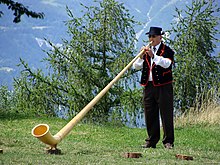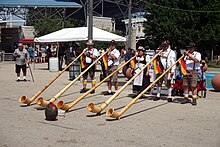Alphorn
 GrindelwaldAlphorn players |

Thealphornoralpenhornoralpine hornis alabrophone,consisting of a straight several-meter-long woodennatural hornofconical bore,with a wooden cup-shapedmouthpiece.Traditionally the Alphorn was made of one single piece, or two parts at most, of the wood of ared pinetree. Sometimes the trees would bend from the weight of snow in winter, and this caused them to have the larger and bent mouthpiece at their ends.[1]Modern Alphorns are sometimes made from three distinct parts that can be attached together: this is to make them easier to transport by car, or even to carry them by hand, and today they are more frequently made from the wood of aspruce treeorfir tree.[1]Thealphornis used by mountain dwellers in theSwiss Alps.Similar wooden horns were used forcommunicationin most mountainous regions ofEurope,from theAlpsto theCarpathians.[citation needed]Alphorns are today used as musical instruments.
History
[edit]
For a long time, scholars believed that the alphorn had been derived from the Roman-Etruscanlituus,because of their resemblance in shape, and because of the wordliti,meaning Alphorn in the dialect ofObwalden.[citation needed]There is no documented evidence for this theory however, and also the wordlitiwas probably borrowed from 16th–18th century writings in Latin, where the wordlituuscould describe various wind instruments, such as thehorn,thecrumhorn,or thecornett.Swiss naturalistConrad Gesnerused the wordslituum alpinumfor the first known detailed description of the alphorn in hisDe raris et admirandis herbisin 1555. The oldest known document using the German wordAlphornis a page from a 1527 account book from the formerCistercianabbey of St. Urban nearPfaffnau,mentioning the payment of twoBatzento an itinerant alphorn player from theValais.
17th–19th century collections of alpine myths and legends suggest that alphorn-like instruments had frequently been used as signal instruments in village communities in ancient times, sometimes instead ofchurch bells.Surviving artifacts, dating back to as far as around 1400, include woodenlabrophonesin their stretched form, like the alphorn, or coiled versions, such as theBücheland theAllgäuischesWaldhornorAckerhorn.The alphorn's exact origins remain indeterminate, and the ubiquity[dubious–discuss]of horn-like signal instruments in valleys throughout Europe may indicate a long history of cross influences regarding their construction and usage.
Construction and qualities
[edit]
The alphorn is carved from solidsoftwood,generally spruce but sometimes pine. In former times, the alphorn maker would find a tree bent at the base in the shape of an alphorn, but modern makers piece the wood together at the base. A cup-shaped mouthpiece carved out of a block of hard wood is added and the instrument is complete.
An alphorn made at Rigi-Kulm, Schwyz, and now in theVictoria and Albert Museum,measures 8 feet (2.4 m) in length and has a straight tube. The Swiss alphorn varies in shape according to the locality, being curved near the bell in theBernese Oberland.Michael Praetoriusmentions an alphorn-like instrument under the name of Hölzern Trummet (wooden trumpet) inSyntagma Musicum(Wittenberg, 1615–1619; Pl. VIII).[2]
The alphorn has no lateral openings and therefore gives the purenatural harmonic seriesof the open pipe.[2]The notes of the natural harmonic series overlap with, but do not exactly correspond to, the notes of the familiarchromatic scalein standard Westernequal temperament.Most prominently within the alphorn's range, the 7th and 11th harmonics are particularly noticeable, because they fall between adjacent notes in the chromatic scale.

Accomplished alphornists often command a range of nearly three octaves, consisting of the 2nd through the 16th notes of the harmonic series. The availability of the higher tones is due in part to the relatively small diameter of the bore of the mouthpiece and tubing in relation to the overall length of the horn.
The well-known "Ranz des Vaches"(score;audio[dead link]) is a traditional Swiss melody often heard on the alphorn. The song describes the time of bringing the cows to the high country at milk making time.[clarification needed]Rossiniintroduced the "Ranz des Vaches" into his masterpieceWilliam Tell,along with many other melodies scattered throughout the opera in vocal and instrumental parts that are well-suited to the alphorn.Brahmswrote toClara Schumannthat the inspiration for the dramatic entry of the horn in the introduction to the last movement of hisFirst Symphonywas an alphorn melody he heard while vacationing in theRigiarea of Switzerland. For Clara's birthday in 1868 Brahms sent her a greeting that was to be sung with the melody.
Music for alphorn
[edit]
Among music composed for the alphorn:
- Concerto Grosso No. 1 (2013) for four alphorns and orchestra byGeorg Friedrich Haas[3][4]
- Sinfonia pastoralefor corno pastoriccio in G (alphorn) and string orchestra (1755) byLeopold Mozart
- Concerto for alphorn and orchestra (1970) byJean Daetwyler
- Concerto No. 2 for alphorn (with flute, string orchestra and percussion) (1983) by Daetwyler
- Dialogue with Naturefor alphorn, flute, and orchestra by Daetwyler
- Super Alpen Kingfor three alphorns and orchestra byGhislain Muller(2001)VSP orkestra/Arkady Shilkloper,Renaud Leipp
- Concertino rustico(1977) byFerenc Farkas
- Begegnungfor three alphorns and concert band, by Kurt Gable.
- Säumerweg-Blues(audio played by Kurt Ott)among many compositions by Hans-Jürg Sommer,Alphorn Musik
- Messefor alphorn and choir by Franz SchüsseleAlphorn-Center
- Erbauliche Studie für 12 Alphörner in Abwesenheit von Bergenby Mathias Rüegg (1998)
- Wolf Music: Tapiofor alphorn and echoing instruments (2003) byR. Murray Schafer[5]
- Le Berger fantaisistefor three alphorns and orchestra byGhislain Muller,Arkady Shilkloper,Renaud Leipp,Serge Haessler,VSP orkestra(2001)
- Bob Downes & The Alphorn Brothers(2015) by Bob Downes Open Music (CD rec. 2004)
- Concerto for alphorn in F and orchestra byDaniel Schnyder(2004)
- Matterhorn(a prelude for alphorn and wind orchestra) by Robert Litton (2013)
- Alpine Trailfor alphorn and orchestra byArkady Shilkloper
- Alpine Sketch "for alphorn and big band by Arkady Shilkloper
- Lai nairfor alphorn and contrabass byJohn Wolf Brennan(2015)
- Der Bergschuhfor alphorn and marching band by Daniel Schnyder
- Crested Butte Mountainfor alphorn and wind band (or brass sextet, strings, or horn septet) by Arkady Shilkloper
- Robinfor alphorn and wind band (big band) by Arkady Shilkloper
- Fanfare for four alphorns by Arkady Shilkloper
- Tanz der Kuhe by Carlo Brunner/Lisa Stoll
In popular culture
[edit]
- The alphorn is prominently featured in advertisements forRicolacough drops, which are manufactured in Laufen, Switzerland[6]
- Brief scene inRammstein's "Dicke Titten".
- The "Horn Top Hop" level in the video gameDonkey Kong Country: Tropical Freezefeatures the Hootz enemies playing alphorns in time with the level's background music.
See also
[edit]- Bucium,a type of alphorn used by mountain dwellers inRomania[7]
- Didgeridoo,an instrument ofAboriginal Australianorigins, traditionally made from a hollowed outeucalyptustree trunk
- Erke,a similar instrument of Argentine Northwest
- Kuhreihen,a type of melody played on an alphorn
- Tiba,wind instrument made of wood or metal that originates in theGrisonscanton; it was used by shepherds on alpine meadows in theAlps
- Tibetan horn,longtrumpetorhornused inTibetan BuddhistandMongolian buddhistceremonies
- Trembita,aUkrainianalpine horn made of wood
- Trutruca,wind instrument played mainly amongst theMapuchepeople ofChileandArgentina;produces a sound that is loud and severe, with few tonal variations
References
[edit]- ^ab"The Making Of An Alphorn".www.nendazcordesalpes.ch/en.Valais drink pure. Archived fromthe originalon 29 October 2021.Retrieved13 October2021.
- ^abOne or more of the preceding sentences incorporates text from a publication now in thepublic domain:Schlesinger, Kathleen(1911). "Alpenhorn, Alphorn".InChisholm, Hugh(ed.).Encyclopædia Britannica.Vol. 1 (11th ed.). Cambridge University Press. p. 723.
- ^"Georg Friedrich Haas".Universal Edition. Archived fromthe originalon 8 February 2017.Retrieved28 December2016.
- ^"EAM: Georg Friedrich Haas'sConcerto Grosso No. 1Debuts with Bavarian Radio Symphony Orchestra ".European American Music Distributors Company. 25 February 2014.Retrieved28 December2016.
- ^Biggs, Charlene (2003)."R. Murray Schafer".CAML Review.31(1).Canadian Association of Music Libraries, Archives and Documentation Centres:46–47.
- ^"By The Way; Come Blow Your Horn".The New York Times.Retrieved13 October2021.
- ^Vitaliev, Vitali."The technology of Alphorn design".eandt.theiet.org/.E&T (Engineering & Technology).Retrieved8 December2021.
Further reading
[edit]- Bachmann-Geiser, Brigitte,Das Alphorn: Vom Lock- zum Rockinstrument.Paul Haupt, Berne, 1999.ISBN3-258-05640-4
- Franz Schüssele,Alphorn und Hirtenhorn in Europa,book and CD with 63 sound samples available atAlphorn-Center,ISBN3-927-78121-5
External links
[edit]- Third Annual North American Alphorn Retreat
- Alphorn in concertArchived2021-06-15 at theWayback MachineConcert and composition contest taking place annually in Oensingen, Canton Solothurn, Switzerland
- International Alphorn Festivalat Nendaz, Canton Valais, Switzerland
- VSP orkestra & Arkady Shilkloperalphorn jazz & improvisations, composer / arranger:Ghislain Muller,Arkady Shilkloper,Pascal Beck
